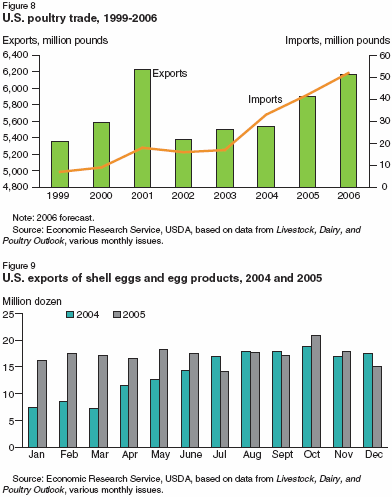



Animal Products Markets in 2005 and Forecast for 2006
By Keithly Jones, Economic Research Service, USDA - Uncertainty continues to shape the forecasts for animal products markets in 2006. Potential and actual animal disease outbreaks, consumer sensitivities, volatile exchange rates, and growing competition from producers in other countries cloud U.S. trade prospects for major meats.
Poultry and Egg Trade
U.S. broiler meat exports are forecast to increase just over 5 percent in 2006, but the export situation is in a state of flux because AI outbreaks have dampened the demand for broilers in Asia, Central Asia, and Eastern Europe. Broiler exports in 2005 totaled 5.2 billion pounds, up nearly 9 percent from 2004 (fig. 8). However, shipments were much weaker than expected in the last quarter of the year as exports fell short of 2004 levels by 14 percent. December shipments to Russia, other countries of the former Soviet Union, the Baltic States, and Eastern Europe were down sharply because concerns about AI reduced consumer demand for poultry meat.
Experience has shown that poultry disease outbreaks result in short-term disruptions of consumption and trade. But, as consumers become more informed about AI, its mode of transmission, and how to handle and cook broiler meat, increased consumer acceptance of poultry products is expected, despite continued news about AI. In addition, low broiler prices should encourage price-sensitive consumers to buy more chicken. Thus, broiler exports through the first half 2006 are expected to exceed those of a year ago and accelerate even further in the last half of the year.
Turkey exports rose almost 29 percent in 2005, to a record 570 million pounds, with a very strong first half. Fourth-quarter 2005 turkey exports were 148 million pounds, up 11 percent from the previous year. Turkey exports are forecast to decline 3 percent, to 554 million pounds, in 2006. Shipments to Mexico were a record 354 million pounds last year but may be pressured by relatively low broiler meat prices. In 2005, Mexico accounted for over 60 percent of U.S. turkey shipments. One of the chief reasons for this increase in demand has been growth in the Mexican economy, which is expected to continue in 2006.
U.S. exports of shell eggs and products (in shell egg equivalent) rose from 167.5 million dozen in 2004 to 203.3 million dozen in 2005, or 21 percent, the highest export level since 1998 when exports reached 219 million dozen (fig. 9). Two main factors were behind the increase. Trade restrictions on U.S. shell eggs and products were lifted following recovery of U.S. layer flocks from the 2003-04 Low Pathogenic Avian Influenza (LPAI) outbreaks. Demand for shell eggs and products from Asian countries rose following the Highly Pathogenic Avian Influenza (HPAI) outbreaks in several Asian countries in late 2003 and 2004.
Asian countries have replaced the traditional countries (Canada and Mexico) participating in the North American Free Trade Agreement (NAFTA) as major importers of U.S. shell eggs and products. For example, U.S. exports of eggs and egg products (in shell egg equivalents) to Japan tripled from 15.7 million dozen in 2004 to 46.1 million dozen in 2005. Similarly, U.S. exports to Hong Kong rose from 14.5 to 24.8 million dozen, and exports to China increased from 2.3 to 5.3 million dozen.
U.S. exports of shell eggs to major Asian markets (Japan, Hong Kong, China, South Korea, Thailand, and the Philippines) increased from 34.9 million dozen in 2004 to 81.7 million dozen in 2005, a rise of over 134 percent. The U.S. export share of total eggs and egg product to these six Asian countries grew to about 40 percent, up from only 21 percent in 2004. The rise in the U.S. egg and egg product export share to Asia nearly matched the decline in exports to the NAFTA countries, the export share of which dropped from 48 percent in 2004 to 31 percent in 2005.
U.S. exports of eggs to the European Union (EU) fell nearly 2 percent to 22.01 million dozen in 2005, but U.S. egg exports to individual EU countries both increased and decreased. U.S. exports rose from 5.3 to 7.5 million dozen for Spain and from 1.4 to 4.3 million dozen for Germany while declining from 12 million to 6.2 million for the United Kingdom. Other growing export markets for the United States include Brazil, rising to 2.7 million dozen from 660,000 dozen, and Israel, up to 4.4 million dozen from 1.2 million dozen in 2004.
Most of the U.S. export growth in 2005 was in processed egg products, which increased from 61.1 million dozen in 2004 to 97.8 million dozen. Exports of shell eggs were up by 2.1 million dozen. Egg exports in 2006 are expected to decline slightly to 200 million dozen, as production by Asian countries previously infected with HPAI slowly recovers. However, U.S. exports to Europe will most likely strengthen, due mainly to competitive prices for U.S. eggs.

Further Information
To read the full article, including other animal product markets, click here (PDF)
August 2006











